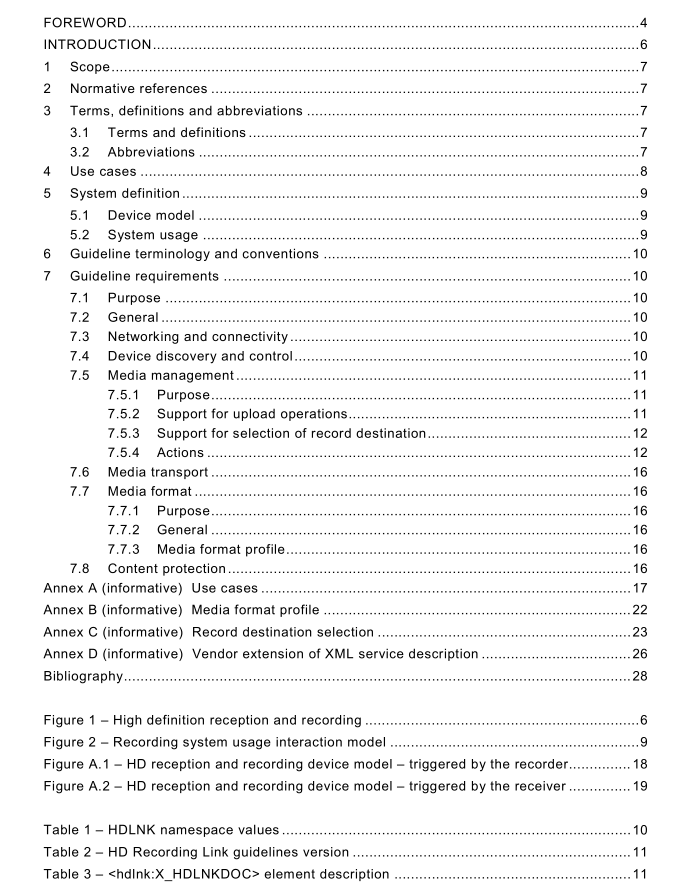IEC 62546 pdf – High Definition (HD) recording link guidelines

IEC 62546 pdf – High Definition (HD) recording link guidelines
7 Guideline requirements7.1 Purpose
This clause covers the guidelines that enable vendors to build HD receivers and recordersthat together, provide HD Recording Link functionality as defined in the current phase.
7.2General
The RcV must fulfil all the guidelines for a DMs device class in IEC 62481-1 and uploadcontroller device capability (+UP+) in lEC 62481-1.The REC must fulfil all guidelines for DMSdevice class in lEC 62481-1 and must accept upload operations from the RCV (see followingsubclause for details).
7.3 Networking and connectivity
The RCV and REC must support the following connectivity selection of lEC 62481-1.
. Ethernet conformant to all [NC Ethernet:] labeled requirements in the general capability
requirements clause of networking and connectivity.
The RcV and REC may support the following connectivity selection of lEC 62481-1.
. 802.11 conformant to all [NC 802:11:] labeled requirements in the general capability
requirements clause of networking and connectivity3.
Any of the above selections can be supported via an add-on card, dongle, or equivalent.7.4Device discovery and control
The device discovery and control should be performed using UPnP device architecture asdescribed in 7.3 of lEC 62481-1.
However,the HD Recording Link devices (RcV and REC) must incorporate the followingchanges to the device description documents.
a) The RCV and REC must employ the
HDLNK guidelines parts.
b) The value of
• hdlnkdoc-value = hdlnk-dev-class”-“hdlnk-version;
• hdlnk-dev-class = “RCV” | “REC”;
• hdlnk-version = major-version”.”minor-version;
• major-version = DIGIT;
• minor-version = DIGIT DIGIT.
The hdlnk-dev-class represents a Device Class of a HDLNK device. The hdlnk-version represents adherence to specific guidelines parts according to 7 7 H Table 2.
The namespace value in the
7.5Media management7.5.1 Purpose
This subclause covers the guidelines for implementing media management, mainly transfer ofcontent, using the DLNA and UPnP Av architecture.
7.5.2Support for upload operations
An RCV must support the DLNA upload controller device capability according to IEC 62481-1,7.4.1.2.4 with the following exception.
. The support for upload functionality as specified in these guidelines is not determined by
the presence of the capability ID (av-upload) in
A REC must support the DLNA upload device option according to IEC 62481-1,7.4.1.7.1 withthe following additional requirements and exceptions.
DLNA OCM content upload operation must be supported according to IEC 62481-1
7.4.1.7.12.1.
• The DLNA advertisement of the upload AnyContainer operation and OCM upload content operation is optional 3 F 4 . More specifically: – it is not required to use the capability ID (av-upload) in
– and it is not required to use @dlna:dlnaManaged attribute to indicate support for OCM upload content operation.
• The support for upload device option as specified in this guidelines must be deduced from adherence of a device to the REC device class specified by
a) CDS:X_HDLnkGetRecordDestinations()– returns a list of possible record destinations. This action is used by RCV to acquire the possible record destinations;
b) CDS:X_HDLnkGetRecordDestinationInfo()– returns properties of a given record destination. This action is used by the RCV to query the status of a given record destination (e.g. media type, total capacity, etc.);
c) CDS:X_HDLnkGetRecordContainerID() – returns the CDS container ID associated to a given record destination. This function is used by the RCV to select a CDS container with a given record destination. The returned container ID is later used in the execution of the CreateObject() action of the upload operation.









